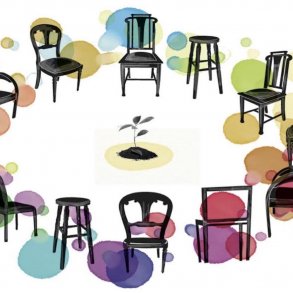By John Hagel III and originally published on typepad.com in edgeperspectives.
We all want to be lucky, but we generally feel there’s little we can do about it. I’ve long challenged the conventional view that luck is just something that happens to us and that there’s little we can do other than be prepared for it when it happens.
I believe that we can significantly alter the probabilities of luck through choices we make on a daily basis – something that I’ve called “shaping serendipity.”
On a very different front, I’ve been exploring for years the power of narrative and, as it turns out, one of the reasons narratives are so powerful is that they can shape serendipity. Let me flesh this out a bit.
Shaping serendipity
First, I’ll address the concept of shaping serendipity.
I’m focusing on a specific form of luck – the luck of unexpected encounters with others that leads to new insights.
I focus on connecting with others because it’s the gift that keeps on giving – rather than a one-time win like winning a lottery or finding a parking spot, meeting others can lead to a stream of insights, rather than just one new idea.
As I’ve written in the past, we can increase the probability of that kind of serendipity through a wide range of choices and actions. For example, we could choose environments that increase the likelihood of unexpected encounters that result in valuable new insights – e.g., we’re much more likely to have those unexpected encounters in a large city than a small village.
Once we’re in those environments, we can adopt a set of practices that will attract the attention of people who turn out to have great insight relative to our interests. And once we have those encounters, we can adopt practices to increase the likelihood of surfacing the most valuable insights that lead to new discoveries.
Some background on narratives
 So, there’s a lot we can do to shape serendipity – but what about narratives? What role could they play in materially increasing the probability of lucky encounters that bring us new insight?
So, there’s a lot we can do to shape serendipity – but what about narratives? What role could they play in materially increasing the probability of lucky encounters that bring us new insight?
Before I answer that question, let me clarify what I mean by narrative. For those who haven’t been following me, it’s important to note that I draw a major distinction between stories and narratives, even though most of us use these words as synonymous with each other.
For me, stories are self-contained – they have a beginning, a middle and an end. Stories are also about the story-teller or about some other people, they’re not about you, the listener. In contrast, for me, narratives are open-ended – there is no resolution, yet.
There’s some kind of opportunity or threat out in the future and it’s not clear whether it will materialize or not. The resolution of the narrative hinges on you, the listener – the resolution will depend in part on the choices you make and the actions you take. So, a narrative is a call to action directed at the listeners, stressing the role that they can and need to play in resolving the narrative.
Narratives play an important role at many levels in our lives. We all have individual narratives (rarely made explicit), institutions have the potential to frame a narrative of their own (but surprisingly few do) and there are a variety of broader social and political narratives. Narratives can shape serendipity at all three levels.
For reasons that will become apparent below, I’m going to focus in particular on opportunity-based narratives, rather than threat-based narratives.
The potential of narratives to shape serendipity
So, how can narratives help to shape serendipity? It’s simple – they harness the power of pull. Effectively framed narratives are designed to inspire and motivate others to come together with us to accomplish something that none of us could fully accomplish on our own.
Serendipity is shaped in part by the ability to attract others – to draw people to us that we never knew existed and that we had no idea could contribute some really valuable insight in some area of interest to us.
 How can we harness that ability to attract others? We need to frame an opportunity that will motivate people to seek us out. That requires an opportunity that’s deeply meaningful not just to ourselves, but to others well. It’s also important to identify an opportunity that can be shared by others – it’s not just about something that will benefit me, but something that we can all benefit from.
How can we harness that ability to attract others? We need to frame an opportunity that will motivate people to seek us out. That requires an opportunity that’s deeply meaningful not just to ourselves, but to others well. It’s also important to identify an opportunity that can be shared by others – it’s not just about something that will benefit me, but something that we can all benefit from.
It would be even more powerful if the opportunity grows as more and more people join the quest to achieve the opportunity. That way, we’re not just sharing a smaller and smaller piece of a fixed pie, but the pie is growing as participation grows. This provides a powerful sense of shared interest – the more who join us, the bigger and more attractive the opportunity becomes.
This can become a strong attractor. Word will spread rapidly that there’s an opportunity really worth pursuing. People are likely to surface from unexpected places, seeking to learn more about the opportunity and how they can participate.
There’s another key element of attraction in narratives. As mentioned, narratives are a powerful call to action but they’re also a plea for help. Narratives represent an acknowledgement that we, the crafters of the narrative, are unable to achieve this opportunity on our own – we need the help of others.
That’s in part why the narrative is unresolved – until and unless we receive that help, the opportunity is unlikely to be realized. That acknowledgement helps to build trust – we’re admitting our own limitations and asking for help. So, not only are people motivated to seek us out and find us, they’re more likely to share ideas with us because there’s a level of trust that invites this sharing.
There’s a third element of narratives that helps to enhance the potential for serendipity – they encourage new ideas. Narratives frame an opportunity at a high level, with enough specificity to be credible and inspiring, but they don’t develop the opportunity in such detail that there’s nothing left to be said.
The most inspiring narratives are those that invite exploration of the full richness of the opportunity and co-creation of the opportunity as it emerges and evolves.
Narratives also leave a large open space regarding the detailed actions required to achieve the opportunity – there’s an invitation to join in crafting approaches that can have greater impact in achieving the opportunity and learning from the experiences to date.
So, narratives represent an invitation to contribute ideas at multiple levels – both in developing a deeper understanding of the opportunity ahead and in evolving more and more effective approaches to achieve that opportunity. As a result, people are motivated to exercise imagination and creativity even before they connect with others to pursue the opportunity. When they show up, they often have ideas that they want to share because they’ve already been inspired to come up with those ideas. Those initial conversations can generate a lot of new insight on both sides because everyone is motivated to seek out ways to achieve even more impact.
Talk about increasing the potential for serendipitous encounters!
Narratives have the potential to attract people we never knew, brimming with ideas about an opportunity that’s meaningful to us and with enough trust to be willing to share those ideas during a first encounter. More fundamentally, they also have the potential to build deeper, long-term relationships where we will not just gain unexpected insight from an initial encounter, but a continuing stream of insights as we join together to pursue that inspiring opportunity.
There’s another, perhaps even more fundamental, way in which opportunity based narratives can help us to shape serendipity – they nurture the emotions that increase luck.
Research by Richard Wiseman and other psychologists and sociologists has shown that we tend to be “luckier” if we’re not driven by anxiety or fear. These emotions tend to reduce our openness to unexpected events. Well, opportunity based narratives help us to overcome those kinds of emotions and tend to nurture optimism and hope, emotions that help us to be more open to those unexpected events.
What we need to do to shape serendipity with narratives
But the key is that we need to be willing to frame a narrative that can be a true catalyst for such serendipitous encounters. That has many challenges.
We need to be willing to invite others to join us on a journey to address an opportunity that extends beyond our narrow self-interest. We need to acknowledge that we alone cannot achieve that opportunity and that we alone don’t have all the answers. We need to be willing to ask for help.
The rewards, though, could be enormous. We could achieve an opportunity that would have been well beyond our reach if we sought to pursue it on our own, an opportunity that’s likely to be even bigger as more participants join in the quest. On the way, we could build a rich network of enduring relationships with people who share our passion for the opportunity and who are committed to working together to achieve something that’s truly inspiring.
Narratives indeed have the potential to shape serendipity. But we need to harness that potential. We need to step back and reflect whether, at an individual level, we have crafted a narrative that has this potential. Most of our individual “narratives” are about us, rather than about opportunities that are bigger than us.
 They’re backward looking, helping us to rationalize how we got to where we are today, rather than forward looking, driven by an opportunity that’s out in the future. They’re about what we are doing to achieve even more, rather than representing a call for help and support from others in achieving an opportunity that’s meaningful to them as well.
They’re backward looking, helping us to rationalize how we got to where we are today, rather than forward looking, driven by an opportunity that’s out in the future. They’re about what we are doing to achieve even more, rather than representing a call for help and support from others in achieving an opportunity that’s meaningful to them as well.
Even if we have an individual narrative that has the potential to shape serendipity, we need to then ask if the institutions we’re part of have narratives that have that same potential. Few institutions today have that kind of narrative.
We have the opportunity to evolve narratives at an institutional level that can significantly amplify the potential for serendipity.
And, let’s not stop there. Let’s also reflect on whether we are supported by narratives at a broader social level that are consistent with, and can amplify, the power to attract the kind of people that can help us to address the opportunities we’ve identified. One of the reasons I’ve stayed in Silicon Valley for decades is because I believe it has a narrative that can significantly amplify my own personal narrative.
I’ve written elsewhere about the need to ensure that narratives at multiple levels – individual, institutional and social and political – amplify and reinforce each other. That applies to the goal of shaping serendipity – we’re likely to be far luckier if we’ve aligned our narratives on these various levels.
The power of attraction can be significantly undermined if there’s a divergence or inconsistency in the narratives that define our context.
Of course, lack of alignment should not be an excuse to give up. We should still seek at a minimum to craft an individual narrative that will increase our ability to shape serendipity for ourselves. All I’m suggesting is that we should consider how aligned our individual narrative is with the institutional and social and political context we find ourselves in. Where feasible, we should seek to influence these broader narratives or consider moving to other institutions or areas that have narrative more aligned with our own. We’ll become even luckier if we can find ways to align narratives at multiple levels.
The bottom line
So far, I’ve been talking about the potential for narratives to shape serendipity as an opportunity. It is a significant opportunity.
But, it’s not just an opportunity, it’s an imperative. In a world of exponential change, where the need is to learn faster throughout our lives, those of us who are “luckier,” those of us who can significantly increase the probability of unexpected encounters that lead to new insight and faster learning, will be the ones to truly thrive and create far more value for ourselves and for others.
What will you do to shape your serendipity?
Additional material
Shaping serendipity – There’s a whole chapter in my book, The Power of Pull, which explores the potential of shaping serendipity – it’s Chapter 3: Attracting What We Need. If you’re so impatient that you can’t wait for the book to arrive, we’ve extracted some of the material on shaping serendipity in this brochure (pdf).
Stories and narratives – I’ve explored this distinction at greater length here (as well as in many subsequent Edge Perspectives blog posts).
Featured Image/graphic link, images in article, and pullout quotes added by Enlivening Edge Magazine. Featured Image Photo by Nong Vang on Unsplash.




